Artists and Their Workplaces
The Search for Proximity
By Peter Letzelter-Smith
When the work of an artist becomes important, it is not unusual for that interest to eventually extend to the place where it was created. What of an artist resides within the walls where they create? As the writer and punk music pioneer — and close collaborator with the artist Robert Mapplethorpe — Patti Smith recounted in M Train about visiting Casa Azul, the home and studio of Frida Kahlo: “I could feel her proximity.” The studios of visual artists are often fascinating in their own right. Whether it’s a pilgrimage to a historic workspace or another way of exploring the work of a contemporary artist, studios are a fascinating addendum to the work itself. Here are 10 studios worth considering.
Barbara Hepworth (Cornwall)

Located in Cornwall’s St. Ives, the Trewyn Studio is where Hepworth worked for 25 years. Her studio embraced not only the traditional workspace but also the grounds, where she created the large figurative sculptures that she’s known for. Managed by the Tate, her studio transitioned into a museum per her instructions and has been preserved almost as she left it, including pieces left unfinished.
Olafur Eliasson (Berlin)
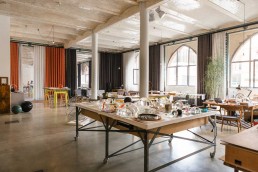
A converted brewery, the Studio Other Spaces is the working home for the Danish-Icelandic artist and his team. Eliasson is best known for his sculptures and large-scale installations. An experimental creator working at the tip of the technological spear, Eliasson’s operation includes over 90 people working in the Prenzlauer Berg district. A testament to the merging of art, design, and architecture that is such an aspect of contemporary public art and installations.
Julian Schnabel (New York)
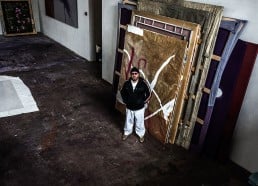
Even from the outside, the Palazzo Chupi in the New York’s West Village is striking. A former horse stable, Schnabel transformed it into a unique building based on the Northern Italian palazzo style. It serves as both residence and studio for its creator and includes several rental units. Its pink exterior and unique design have made it one of New York’s many architectural touchstones. Some critics consider it a work of art in its own right and some critics feel, well, otherwise.
Irma Stern (Cape Town, South Africa)
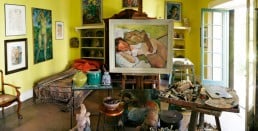
The painter, who died in 1966, worked in the space that is now preserved as a museum for decades. Considered avant-garde when first building her career before World War II, her paintings ran afoul with the conservative government of South Africa. Today, her studio is preserved as a cultural touchstone and the building has been adapted to include a gallery dedicated to the diversity of contemporary South African art.
Tauba Auerbach (Brooklyn)
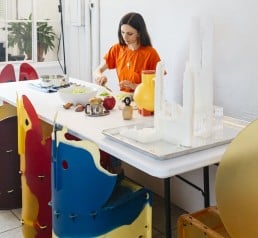
A few decades ago a successful, New York-based, cutting-edge artist like Auerbach would be working in SoHo or The Village. But for a number of reasons, that scene has moved across the East River to Brooklyn. An artist working over a wide range of media — painting, artists’ books, album covers, photography, and sculpture — Auerbach’s studio features tall ceilings and exposed brick walls. The kind of converted industrial space that Brooklyn is now known for.
Georgia O’Keeffe (Abiquiú, New Mexico)
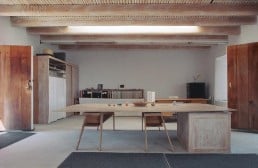
One of the iconic studios in modern art, O’Keeffe’s desert home was purchased at the end of World War II as she transitioned her life away from New York. Now a National Historic Landmark, it is here that O’Keeffe created the desert-themed landscapes of her later period. The building’s soft, whitewashed walls of adobe and interior bathed in the sunlight of the desert sky are echoed in those paintings.
Jackson Pollock and Lee Krasner (East Hampton, New York)
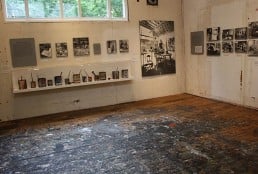
The studio of two prominent artists, Pollock and Krasner bought this property at the end of Long Island at about the same time O’Keeffe was purchasing Abiquiú. Also now a National Historic Landmark, Pollock painted in the studio here until his death in 1956. Splashes from his action paintings are visible on the floorboards. Krasner painted in the house while Pollock was still alive and in the studio into the 1970s. The site includes a study center, exhibitions, and archives of Pollock and Krasner’s careers.
Rachel Feinstein (New York)

An artist known for the fantastical, fairy-tale imagery with which she infuses her sculpture, Feinstein’s SoHo studio is littered with books, paper figurines, and models for full-sized sculptures. One-half of what the New York Times in 2011 dubbed “the ruling power couple in today’s art world” — she’s married to the painter John Currin — her work has been featured in pivotal gallery exhibitions and as part of public installations in New York’s Madison Square Park.
Francis Bacon (Dublin, Ireland)
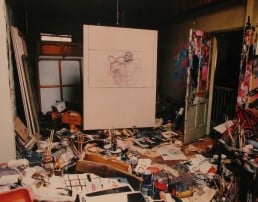
The studio of the late Francis Bacon can be visited today — but not in the city where the artist actually worked in it. After his death in 1992, Bacon’s London studio was carefully crated and transported to Dublin, Ireland — the artist’s birthplace. It is now housed — in all its stereotypical artist’s “disaster zone” slovenliness — at The Hugh Lane. The process of moving and cataloguing Bacon’s chaotic workspace was a testament to the craft of museum archivists.
Frida Kahlo (Mexico City)
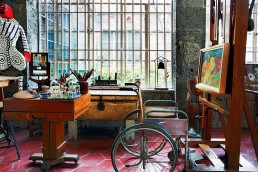
Along with O’Keeffe’s Abiquiú, one of the true pilgrimage sights when it comes to artist’s studios. It is here that Kahlo painted her famous self-portraits while immobilized after the bus accident that altered the course of her life. In the “blue house” was also where she was born and died. She lived for some years here with the painter — and her husband — Diego Rivera. Now a museum celebrating both of their work — along with the Mexican folk art that inspired them — it is one of the most visited museums in Mexico.
Get your free copy of Artland Magazine
More than 60 pages interviews with insightful collectors.